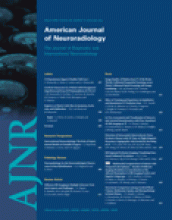Abstract
BACKGROUND AND PURPOSE: The purpose of this study was to determine the efficacy and rate of complications in patients undergoing percutaneous vertebroplasty (PVP) for vertebral compression fractures as a result of secondary osteoporosis caused by long-term corticosteroid use compared with patients with primary osteoporosis treated with PVP.
MATERIALS AND METHODS: A retrospective review of all patients undergoing PVP was conducted to identify patients who also received long-term corticosteroid therapy. Outcomes including pain, periprocedural complications, and frequency of new fractures in patients receiving corticosteroids were compared with control patients undergoing PVP for primary osteoporosis.
RESULTS: Sixty-eight patients receiving long-term corticosteroid therapy underwent 79 PVP procedures. Patients treated with corticosteroids undergoing PVP were significantly younger and more likely to be male compared with control subjects. Patients receiving long-term corticosteroid treatment experienced significant pain relief immediately postprocedure and at 1 week, 1 month, 6 months, 1 year and 2 years postprocedure (P < .0001 at all time points). Patients receiving corticosteroids experienced similar decreases in pain from baseline compared with control subjects at all follow-up time points (P > .05). The complication rate for patients receiving corticosteroids was 4.4% compared with 3.4% for control subjects (P = .60). Patients on long-term corticosteroid treatment did not have an increased risk of new fractures after PVP compared with control subjects (P = .68).
CONCLUSIONS: Percutaneous vertebroplasty performed for vertebral compression fractures as a result of long-term corticosteroid therapy is as safe and effective in relieving pain as PVP performed in patients with vertebral compression fractures as a result of primary osteoporosis.
- Copyright © American Society of Neuroradiology












